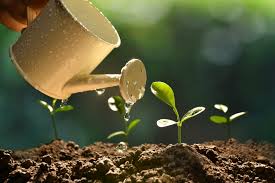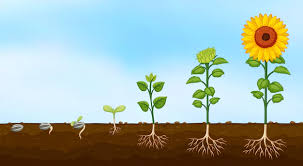All the developmental processes occurring in plants involve growth. The growth of plants involves various changes such as the addition of new cells through cell division, an increase in size and weight, and an irreversible increase in volume.
Therefore, growth is defined as a permanent and irreversible change in the size of a cell, organ, or whole organism, usually accompanied by an increase in dry weight. This growth is dependent upon a number of factors, some of which are external while others are internal.
Factors that influence the growth and development of plants can be broadly divided into two: internal factors and external factors.
Internal factors consist of things that are inherent in the plant, like crop type and variety. A crop or plant is known by the class it belongs to, and those characters that distinguish one plant from another are purely hereditary.
Also, the presence of enzymes and hormones affects plant growth and development. External factors are those factors that are environmental in nature to the plant.
The plant cannot influence what happens around it but can adapt to changes in the environment. These external factors include light intensity, water adequacy, temperature, and minerals.
Both internal and external factors control the growth and development of plants through their influence on internal activities such as the processes of photosynthesis, respiration, protein and chlorophyll synthesis, osmotic pressure, and mitosis.
Read Also: How to Farm and Care for Daggertooth Pike Conger Fish (Muraenesox cinereus)
External Factors Influencing Plant Growth and Development

Plant growth is influenced by a variety of external factors. These include light, temperature, water, and nutrients.
Light as an Environmental Factor in Plant Growth
There are two major effects of light on plants: one is related to photosynthesis and the other to growth and morphogenesis. The effect of light on photosynthesis, growth, development, and differentiation in plants is called photomorphogenesis.
All these processes are light-dependent.
For example, if a plant is allowed to grow in complete darkness, it shows marked etiolation (i.e., the phenomenon exhibited by green plants when grown in darkness).
The seedlings grown in dark are pale, elongated with primary leaves unexpanded and yellow. On the other hand, the seedlings grown in light are sturdy, green with shorter internodes, expanded leaves, and upright apex.
These effects are in response to light. Besides this, most of the processes in plants are controlled by light, such as reproduction, seed germination, seedling growth, and differentiation in various tissues and organs.
Temperature and Its Role in Plant Growth and Development
Temperature is a primary factor affecting the rate of plant growth and development. Plant growth is the result of cellular metabolism and processes. Since the metabolic activities of plants are directly affected by variation in temperature, their growth rate is also influenced.
The rate of growth of plant tissues increases with increasing temperature up to optimum levels, after which it declines as the temperature becomes extreme.
The temperatures for optimal growth vary with the type of plant. Some annual flowers and vegetables are extremely sensitive to cold, whereas some plants require cold treatment in order to stimulate flowering in later stages.
Germination of seeds in plants is also affected by extreme temperature conditions. Some seeds of winter-season crops germinate at 5ºC to 25ºC, while seeds of summer crops germinate at 10ºC to 35ºC.
Read Also: Apple Maggot: Description, Damages Caused, Control and Preventive Measures
Importance of Water in Agricultural Plant Growth

Water is necessary for virtually every function of plant growth. It is used in photosynthesis and other metabolic processes and then ultimately lost by transpiration.
Excessive transpiration or water deficiency in the soil causes water stress in the plants. Plant growth is considerably retarded during water stress, but sometimes excessive water also stops the growth of the plant.
Shortage of water damages plant cells, resulting in decreased growth, wilting, and leaf scorch, and eventually leaf drop and root damage, while too much water reduces the amount of oxygen in the soil, resulting in root loss or injury. It can also make the plant more susceptible to many fungal diseases.
Nutrient Availability and Its Impact on Plant Development
Plants require nutrients in the form of inorganic ions for normal growth and development. Almost every metabolic process in plants requires inorganic nutrition. Thus, the growth of plants greatly depends upon the supply of these essential elements. In the absence of these elements, plant growth becomes retarded.
Plants obtain inorganic nutrients from the air, water, and soil. For example, carbon and oxygen are obtained from carbon dioxide and hydrogen from water.
They also absorb a wide variety of mineral elements from the soil, such as nitrogen, phosphorus, potassium, calcium, magnesium, iron, zinc, and boron.
Internal Factors Controlling Plant Growth and Differentiation
These internal factors are mainly genetic and hormonal in nature.
Role of Plant Hormones in Growth and Development
In addition to temperature, water, and inorganic nutrition, the growth and differentiation of plants also depend on plant hormones. These plant hormones are also known as plant growth regulators.
They regulate the distribution and fate of nutrients in different organs of the plant body.
Plant growth regulators are broadly divided into two groups based on their functions in a living plant body. One group is involved in growth-promoting activities, such as cell division, cell enlargement, pattern formation, tropic growth, flowering, fruiting, and seed formation.
The other group is involved in various growth-inhibiting activities such as dormancy and abscission. They also play an important role in plant responses to wounds and stresses of biotic and abiotic origin. Thus, these hormonal factors play a major role in the growth and differentiation of plants.
Genetic Control of Plant Growth Characteristics
The seed of mango germinates to produce a mango plant; it never grows into a palm tree. Similarly, a tomato seed gives rise to a tomato plant. All the information about the form and shape of the plant body and the specific pattern of growth and differentiation in plants is stored as genetic information in the genes located inside the cell of a seed.
As the development processes begin, the genetic information is passed from genes to RNA to proteins within the cells. Some very specific genes are responsible for the synthesis of specific enzymes (proteins), which then catalyze specific biochemical processes necessary for growth and differentiation in plant cells.
The growth of a plant is dependent on various factors, which may be internal or external. This is because these factors are directly or indirectly involved in various morphological, physiological, and developmental processes in plants that are necessary for overall growth and development.
Factors that influence the growth and development of plants can be broadly divided into two: internal and external factors. The external factors include light, water, temperature, and minerals.
These factors, either internal or external, control the growth and development of plants through their influence on internal activities such as photosynthesis, respiration, protein and chlorophyll synthesis, osmotic pressure, mitosis, flower and seed formation, dormancy, and seed germination.
Do you have any questions, suggestions, or contributions? If so, please feel free to use the comment box below to share your thoughts. We also encourage you to kindly share this information with others who might benefit from it. Since we can’t reach everyone at once, we truly appreciate your help in spreading the word. Thank you so much for your support and for sharing!
Frequently Asked Questions
We will update this section soon.

